• Part 1: An Overview
• Part 2: Towns & Villages along the Burgundy Canal
• Part 3: Best Places to Visit near the Burgundy Canal
The Ultimate Guide to the Burgundy Canal
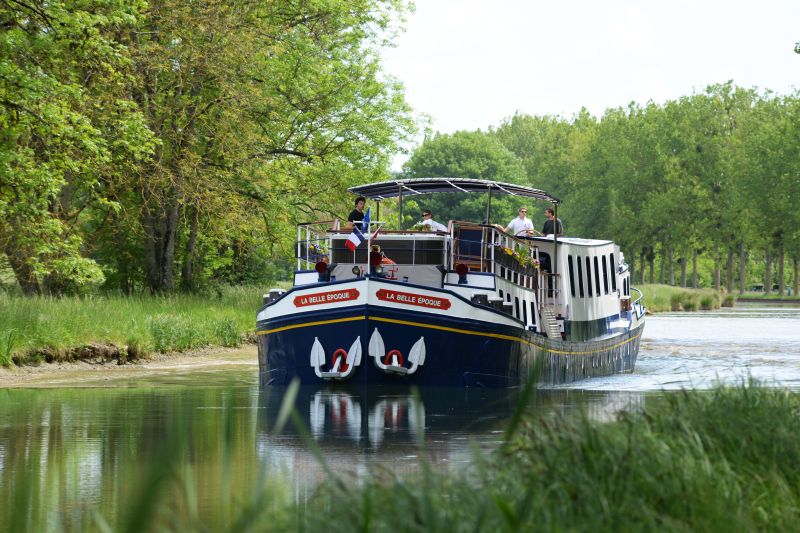
Part 1: The Burgundy Canal – An Overview
The Burgundy Canal is 150 miles long with 189 locks and connects the River Yonne at Migennes with the River Saone at St-Jean-de-Losne. It has the highest summit of any canal in France, reaching 378m (980 ft) above sea level at the summit, which is the 2 mile long Pouilly tunnel.
The history of the Burgundy Canal is long and complicated. Although the first act in support of its construction was the 1607 tax placed on local farmers to help finance a segment of the waterway, the final route was not agreed until more than 100 years later.
In the mid-17th century Pierre Paul Riquet, the chief engineer of the Canal du Midi, proposed a route which was thought to be too expensive, then in 1696 the military engineer Vauban proposed five different designs, one of which was ultimately adopted 30 years later. However, work did not begin until 1777, at the beginning of the reign of Louis XVI.
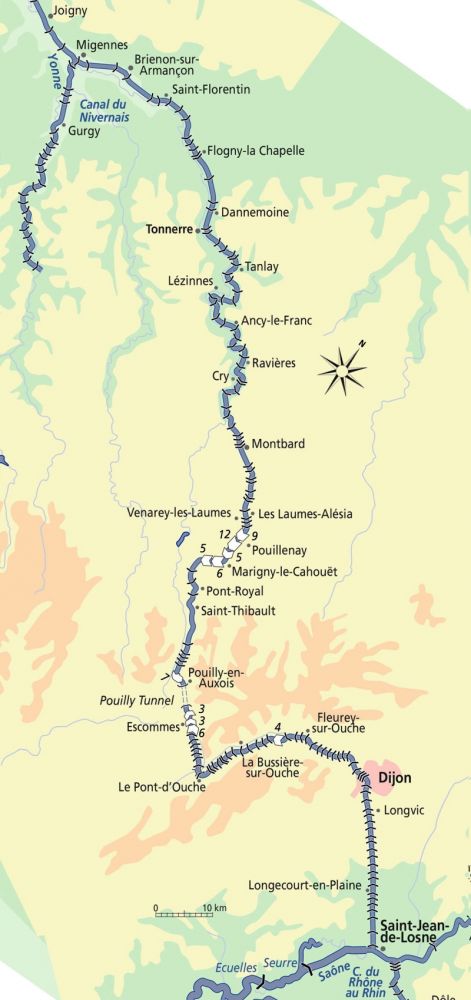
Construction of the Burgundy Canal began in the west, alongside the River Yonne, working upstream towards the town of Tonnerre. A few years later, work began on the Saône side in the east, working west towards Dijon. The Yonne side of the Burgundy Canal fell rapidly behind schedule, and, due to inadequate funding, the construction of that section halted in 1793.
The French Revolution and the Napoleonic Wars further slowed progress on the construction. The State of Burgundy, however, pushed ahead, completing the first segment of the Burgundy canal between the city of Dijon and the River Saône 15 years later so that in December 1808 the first barges arrived in the port of Dijon. Yet even with the support of the Emperor Napoleon , the completion of the full canal still met numerous delays due to problems with financing and construction. Finally the necessary funds were secured and the project was brought to completion. In late December 1832 the first boat to traverse the entire route of the Burgundy Canal set out from Paris, arriving in Dijon on January 3, 1833. The canal at last connected the north of France to the south and the River Seine to the River Rhône. One of the final challenges of the construction project was the complicated and impressive Pouilly Tunnel, which forms the summit. The building of the tunnel started in 1826 and took six years to complete, some say partly with forced labour in the form of English prisoners of the Napoleonic Wars.
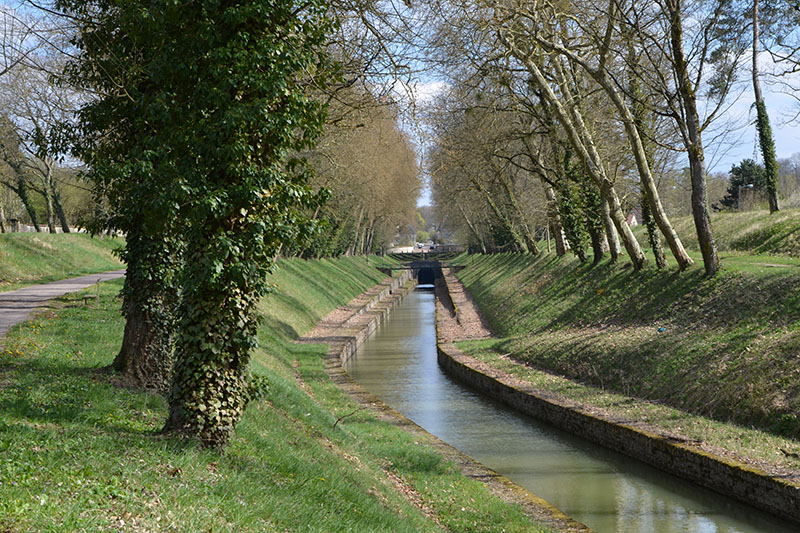
The tunnel is two miles long and runs in a straight line. At the time of construction, 90% of the work had to be done by hand which was a hard and dangerous job. At its deepest section, the tunnel runs 150 feet below the surface. 32 shafts were constructed to assist in hauling the spoil to the surface during the digging and today, these shafts provide ventilation to the boats passing through the tunnel below.
In the early years of the tunnel’s use, bargees had to pull their barges along the length of the tunnel using a chain attached to the wall with passage through the tunnel taking up to 10 hours. In 1867 a steam tug was put into use to haul barges through the tunnel and in 1893, this was replaced by an electric tug , greatly reducing passage time. Although the tug is no longer used, visitors can still see it displayed in the small town of Pouilly-en-Auxois.
As well as constructing the Burgundy canal itself, the builders had to address the problem of water supply which was particularly acute due to the height of the summit at Pouilly and the limited amount of natural water. In the end, two supply channels and seven reservoirs had to be built to store water upstream and keep the canal full during periods of drought. Even today, maintaining an adequate water depth in the canal is a constant challenge.
Further construction included housing for lock keepers, as well as “maison gardes” which were occupied by teams of maintenance workers who would move along the canal to do repair work. Today, almost all the lock houses remain, but many of them have become holiday cottages as the numbers of lock-keepers has fallen. Now, one keeper services a number of locks with the help of some automation and a car or scooter to move quickly between the locks in his or her charge..
Like the other canals in France, by the mid-19th century its commercial importance of the Burgundy Canal was starting to wane. By 1882, lock sizes had been increased to the Freycinet standard to allow 250 tonne barges to pass, but speeds were still slow compared to newly arrived rail transport, particularly with the Pouilly tunnel which only permitted one way traffic. Fortunately, in more recent times, tourism has breathed new life into the waterway and the towns it serves, and today the Burgundy Canal is one of the most popular pleasure-boat destinations in France.
In addition to the undulating countryside and the historical significance of a number of the towns on its route, the region is, of course, famous for its superb wines.
Part 2: Towns & Villages along the Burgundy Canal
The fortified hilltop town of St-Florentin lies at the juncture of two rivers, the Armance and the Armançon, as well as being one of the first towns on the Burgundy Canal when joining from the River Yonne. In addition to its many stone buildings, the town is capped by its church (built between 1500 and 1614), which has lovely stained glass windows by the Troyenne school.
Located where the Armançon divides into several channels, Tonnerre is a sizeable town dating back to the Roman period, although it was largely rebuilt after a devastating fire in 1556. Many of its ancient houses sport red-tiled roofs. Notre-Dame des Fontenilles is a hospital founded in 1293 by Marguerite de Bourgogne, sister-in-law of Louis IX. The main hall of the hospital, the Grande Salle, is 280 feet long with vaulted oak ceilings.
In the town’s centre is the Fosse Dionne, a basin fed by the green waters of a natural underground spring. In the Gallo-Roman period, its waters supplied the hilltop settlement (or Oppidum) for drinking and washing. In 1758 a local nobleman, Louis d’Éon, converted the spring into a wash-house and since 1920 it has been listed as a historic monument Louis d’Éon’s son, Chevalier d’Éon, grew up to be a famous dignitary of Tonnerre. Chevalier had androgynous (feminine) characteristics and natural abilities as a mimic; good features for a spy. In 1756 he joined a secret network of spies called the Secret du Roi, employed by King Louis XV but without the knowledge of his government. He appeared publicly as a man and undertook male occupations, however during this time he was able to infiltrate the court of Empress Elizabeth of Russia by posing as a woman. Later in his life he was sent to London to help draft the peace treaty that would officially bring an end to the Hundred Years War. He subsequently became paralysed after suffering from a fall and spent the last four years of his life bedridden. He died in poverty in London in 1810 and is buried in St Pancras Old Church.

Surrounded by rolling hills where white Charolais cattle graze and where mistletoe hangs from poplars, Tanlay seems right out of a picture book. The Château de Tanlay, one of the finest in Burgundy, was built in the 15th and 16th centuries and has a beautifully decorated interior. Surrounded by a series of moats, arcades and iron grills, the château is set in glorious parkland.
The town of Ancy-le-Franc has a market and a magnificent Renaissance château, which hosted many prestigious guests, including Henry IV, Louis XIII, and Louis XIV who stayed in the Blue Room, or Salon Bleu.
Built in the 16th century by Italian architect Sebastione Serlio, the château has a plain, austere, grey stone exterior, with massive square towers and a grand front entrance. Its lavish interior is richly-decorated, with carved or painted walls and ceilings.
The small village of Ravières has a church built in 1701, and was added to the list of Historic Monuments in 1913. It is also the site of the once famous “pottery barge,” whose owner would cruise from village to village selling plates, bowls, and jugs. Today it is also the location of European Waterways’ French headquarters and the maintenance base for its hotel barges.
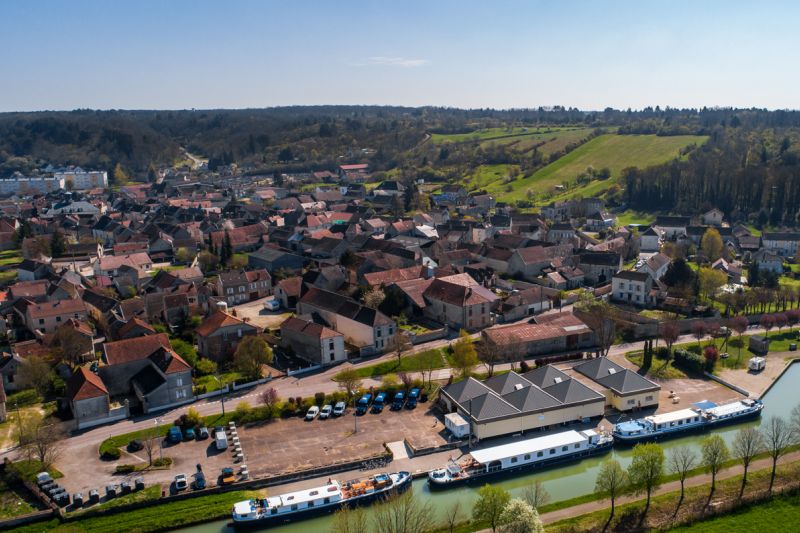
The Forges de Buffon were built in 1768 by the Comte de Buffon, an iron-master whose industry was an economic boon to the nearby town of Montbard. The water was damned and controlled to power the water-mills which in turn powered blast furnaces. This system was years ahead of its time and was an important influence in the beginnings of the industrial revolution in France. After serious floods, the forge was converted into a cement factory and then ceased activity altogether. The forges have since undergone extensive restorations and are today open to the public.
Montbard is a small industrial town and a metallurgical centre, once home to the 18th century iron-master Comte de Buffon, who was responsible for much of the town’s wealth. The Comte was also a naturalist, whose daily observations led to the publishing of the Histoire Naturelle over a 40-year period. The town has a Hôtel Buffon, the Buffon Institute, Buffon Park, and the Comte is buried in… Buffon Chapel!
Venarey-les-Laumes is a railway junction and the capital of the Auxois region. The town looks out over the Laumes plain, where Julius Caesar conquered the Gauls in 52 BC at the Battle of Alesia. It is claimed that Caesar’s victory over the combined Gallic forces helped establish Roman dominance in Gaul for the next 500 years.
Pouillenay is a village famous for the anise-flavoured sweets which have been made there since the 9th century.
The neighbouring village of Flavigny-sur-Ozerain has itself found more recent fame in the confectionery world as the setting for the 2000 film Chocolat.
St-Thibault has a 13th century priory which houses the saint’s remains. “A hermit, Theobald became a priest and was said to have performed several miracles, being subsequently canonised by Pope Alexander II in 1073.
Vandenesse-en-Auxois, a quiet village near the summit of the Burgundy canal and the village of Châteauneuf with its spectacular hilltop castle marks the beginning of the Auxois plain.
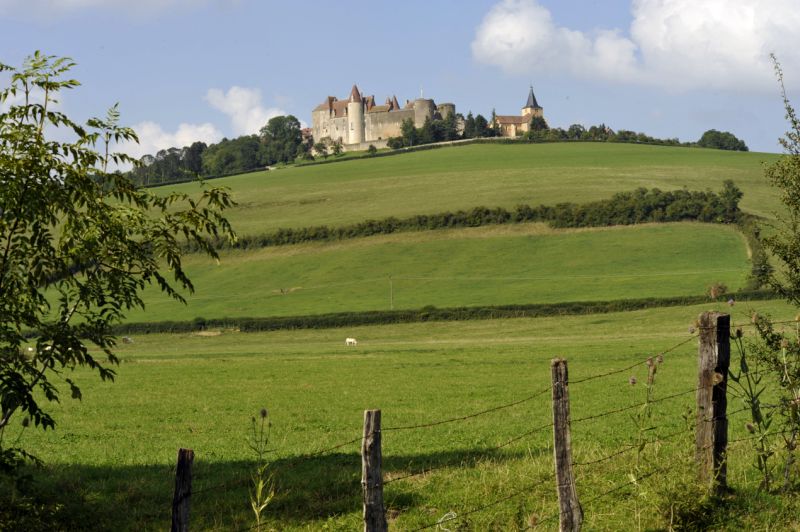
Pouilly-en-Auxois is a large and flourishing town with a spacious port located in a sizeable basin at the summit of the Burgundy canal. The town thrives on agriculture and tourism. Nearby is the fascinating two-mile long Pouilly Tunnel.
Escommes is a hamlet which marks the summit of the canal, and features a loading dock, once used to transport empty barges through the Pouilly tunnel. The turbine house which provided hydro electric power for the electric tug can also be seen with its sluice gate system to divert water from the canal to drive the turbines and generate power.
Pont d’Ouche has, as the name suggests, an aqueduct with three-arches which carries the Burgundy canal over the River Ouche, one of the very few on the Burgundy Canal. It is here where the River Ouche meets the canal and follows it all the way to the River Saône. Once a centre of tile production, barges would carry them as cargo to be distributed and sold in larger towns and cities.
There is often an early morning mist and a mirror reflection on the canal surface here and at sunset you may see deer and wild boar coming down from the forest to drink. However, the most important thing about Pont-d’Ouche may be the “English” bar where surely many a bargee has spent an evening!
La Bussière-sur-Ouche has a number of well-kept stone cottages as well as a restored 13th century Cistercian abbey, St-Victor-sur-Ouche. The village is actually split into two very distinct parts, “La Forge” which the Burgundy canal runs through, and “La Bussière” with the abbey.
The abbey grounds are a place of calm and meditation where you can walk in the footsteps of the monks; there are beautiful springs, streams and fountains, as well as some unusual buildings, such as a dovecote dating from the 15th century. Tombstones of Crusading knights can also be seen in the gardens. Today the Abbey is run as a hotel and retreat. Two streets from the canal is the little Romanesque church L’Eglise de l’Assomption which features a distinct slate steeple.
The grounds of the Château at Barbiery-sur-Ouche contain a very impressive and renowned collection of wild flowers, and were inscribed on the list of National Monuments in 2005. On the hill top are the ruins of a feudal château once owned by the Marigny family. Nearby at Roche Chèvre are the remains of a Tumulus, or Visigoth burial site and a cave which could well have also been used for neolithic burials.
Gissey-sur-Ouche is a hamlet of approximately 350 inhabitants. With a few canal-side cottages, the Mairie and wash house it is one of the most charming villages along the Burgundy Canal.
Sainte-Marie-sur-Ouche lies in a deep and narrow valley created by erosion-resistant limestone dating from the Jurassic period. Pont de Pany, a hamlet near Sainte Marie-sur-Ouche, was once a very important bread market, as the name might suggest. A bridge crossing the river Ouche was an important crossroads for trading routes during the Middle Ages.
Fleury-sur-Ouche is a very traditional village offering all the charm of France. There are many small streets to explore, with plenty of little boutiques, a café and some very old houses!
Dijon is a modern, growing city with a well-designed canal port. It is the centre of the Côte d’Or and was the ancient capital of Burgundy in the 14th and 15th centuries. Visitors can wind their way through the narrow streets of the old quarter and are drawn to the city’s numerous museums, the Ducal Palace which opens onto the square, the Parliament Building and the 13th century Cathedral St-Bénigne with its Romanesque crypt.
Several of the buildings in Dijon sport roofs of glazed tiles with varied colours and patterns. And, of course, the mustard merchants sell their product in beautiful faïence jars. It is thought that the recipe for the world-famous condiment dates to the 4th century AD. Don’t miss the city market where a huge selection of local delicacies are always on sale.
Château de Longecourt was built as a fortress in the 12th century and transformed into a château in the 17th century. In order to be designated a chateau in France, the property must have a well and a chapel, which is why many chateaux don’t look like castles but stately homes. Further embellishments were added in the next century, resulting in the neoclassical Italian style home of today. Surrounded by moats and four towers, the Château is situated in a 100-acre park.
St-Jean-de-Losne sits at the juncture of the Saône with Burgundy Canal. Even before the advent of the canal, the town was a thriving river port. In 1273, the lords of Franché-Comte laid siege to the town with 500 troops dressed up as women. The town uncovered the ruse and killed all of the attackers. In 1636 80,000 troops of the Holy Roman Empire threatened the town.
With 400 citizens and 150 soldiers, to which were added 800 reinforcements from nearby Auxonne, the town miraculously held off the siege. Thereafter the town was known as La Belle Défense. In 1870 a German advance was also turned away. Clearly this is a town which values its independence.
A large basin, once used to store timber being floated down the river, is now a port used for mooring recreational craft, and is today the largest of its kind in France, and an incredible depot for all things to do with barges. Whether you need water pumps, engines or propellers, St-Jean-de-Losne is the place to come! A gymkhana, or rally, is held yearly for boating enthusiasts. In a restored 15th century house is an exhibition titled “The Barges of St-Jean-de-Losne,” housing a complete collection of barge equipment, hand pumps, bailers, and wooden jacks used to raise boats in dry dock.
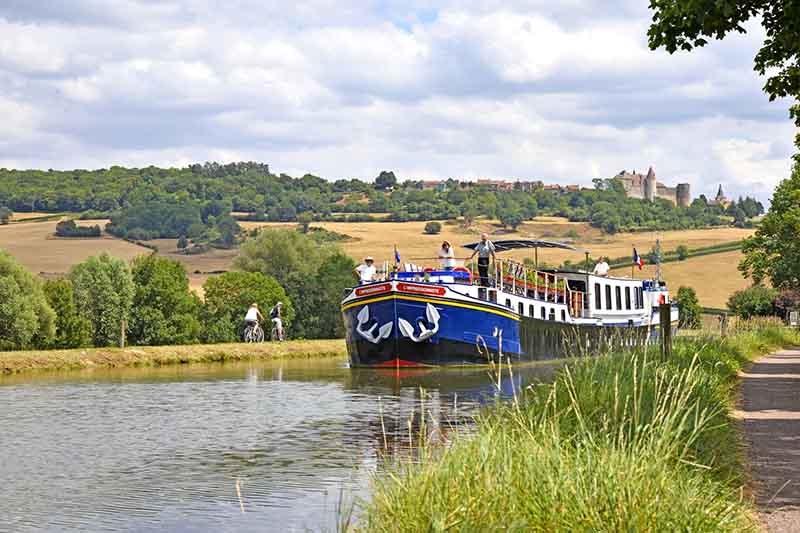
Part 3: Best Places to Visit
The capital of the Burgundy wine country, Beaune is one of the best preserved medieval cities in Burgundy. Until the 15th century, Beaune was the residence of the Dukes of Burgundy. France eventually took the town from the Burgundians in 1477 after the Duchy was annexed by Louis XI following Charles the Bold’s death.
First a Gallic sanctuary and then a Roman town, Beaune is now a mecca for wine lovers. This thriving town is surrounded by ramparts and has a labyrinth of caves (wine cellars). During its three-day festival and wine auction in November, free wine-tastings draw huge crowds, many of whom arrive thirsty and leave satisfied, albeit a little tipsy!
The Hôtel-Dieu, a charity hospital funded by the sale of wines produced on lands donated by its benefactors, was, until 1971, a working hospital. It had been constructed originally to provide free care for men who had fought in the Hundred Years’ War. Today, the Musée de l’Hôtel-Dieu displays Flemish-Burgundian art and the Grand Salle at 165 feet long, is a showpiece to display its original furniture.
Its roof tiles, which have become world-renowned, are polychromatic in the Burgundian-style and date from the Renaissance.
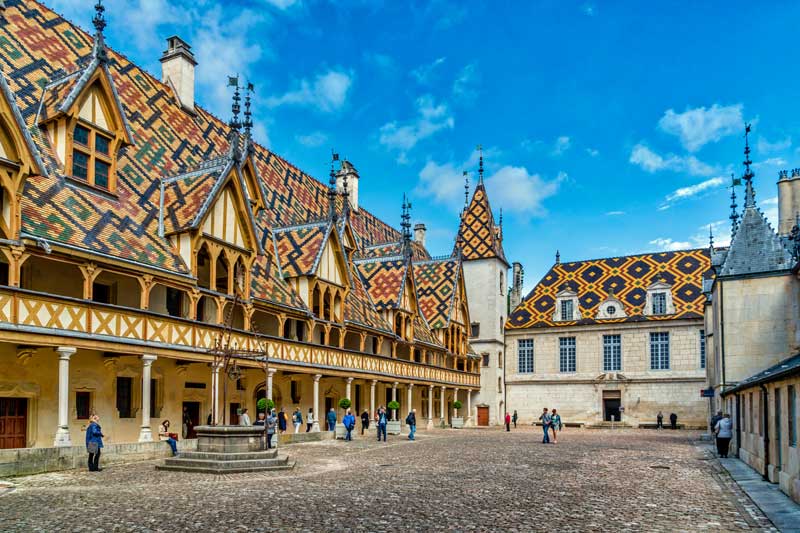
On the banks of the River Serein, Chablis is a pretty little town. Known as the “Golden Gate” of Burgundy, it is famous the world over for its crisp dry white wines. Visitors enter through the turreted towers of the Porte Noël gateway, opening on to narrow stone streets and houses dating from the 14th to 16th century. St-Martin’s collegiate church, whose construction started in 1160, was one of the first French churches of Gothic design. It is a miniature copy of the cathedral of Sens. Saint Martin was known as the patron saint of travellers, and his relics are kept in the church to which he gave his name. The hospice, or Hôtel Dieu, dates from the 12th century.
Premontré order. It is said that Joan of Arc slept there, one night in February of 1429, on her way to Chinon.
Châteauneuf-en-Auxois is a tiny, charming, hilltop village, well worth the climb up the steep path. This romantic and fascinating bastide (fortified town) has a turreted castle, encircling walls, and elegant houses once belonging to rich merchants. The château, built in the 12th to 15th centuries, affords a broad vista over the rolling farmlands, the Burgundy Canal and the woodlands of the Morvan Forest. At its peak, the town had a population of 500; today it has approximately 90.
The Petit Pontigny is a set of buildings, surrounded by walls, which is at the centre of all festivities and ceremonies of Chablis and its famous vineyards. Its cellar, also dating from the 12th century, is now the only original part of this property, which once belonged to the monks of Pontigny. Nearby is the St-Cosme priory, which was built in the 12th century by the monks of the Château de Commarin has been in the hands of the same family for 26 generations – which is more than seven centuries! This once fortified castle, built in 1346, underwent radical transformations in the 16th century to convert it into a modern habitation and was further reconstructed in the 17th and early 18th centuries. Today two large towers and a small chapel are the only 14th century structures that remain. The existing château was built in the 18th century by the Marquis d’Antigny, minister for Napoleon, and the Marquise d’Antigny, grandmother to the Prince de Talleyrand. The château houses a collection of tapestries from the 16th century and rare examples of period furniture and other objects.
The Clos de Vougeot is one of the largest vineyards in Burgundy. The Château de Clos de Vougeot is a small château built to house the wine presses needed by the Cistercian monks to make wine for their religious ceremonies. The château is now the seat of Burgundy’s most sophisticated wine lovers, the Confrérie des Chevaliers du Tastevin. In Epineuil is the Petit Quincy Abbey, built in 1212 by the Cistercian order. In this magnificent setting, great Epineuil and Chablis wines are produced.
Irancy is possibly most famous for its wines; the area predominantly produces red wines from the Pinot Noir variety, however a small amount of rosé wines are also made. Irancy’s unusual topography – it lies in a valley whose slopes are covered with vines and cherry trees – shelters it from the worst of the winter weather, whilst also allowing for sufficient sun to ripen the grapes. The area is one of the most northerly for red wine grape growing.
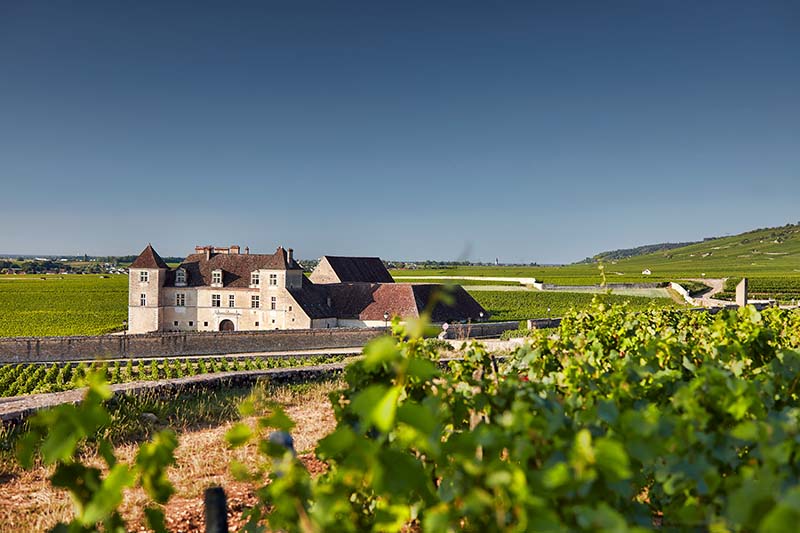
Meursault is a large, well-to-do town. It is at the entrance to the great white wine producing basin of the Côte de Beaune, where vineyards spread over gentle slopes. The town’s origins lie with a Gallo-Roman settlement, Mont Mélian, and the remains of its fort are still visible on a hill above the village. Later, in the Middle
Ages, the town served as a base for treating leprosy in the Hôpital de Meursault. Today the town is the home of an international wine festival, La Paulée de Meursault and its eponymous white wines are some of the most celebrated in Burgundy.
Château d’Époisses is a medieval castle, which has been in the same family since 1661. The village is famous for its creamy, soft but very pungent cheese, which is washed in Marc de Bourgogne (a local spirit) which helps it to ripen in the cellars of the village.
Nearby is the Cistercian Abbey of Fontenay. Founded by St-Bernard in 1119, it is described by UNESCO as being “an excellent illustration of the ideal of self-sufficiency as practiced by the earliest communities of Cistercian monks”.
Having been ravaged and abandoned during the French Revolution, and later serving time as a paper factory, the Abbey has been so carefully restored that it is now the most complete remaining medieval monastery in France. As a testimony to the monastery’s desire to be self-sufficient, the complex includes cloisters, dormitories, outbuildings, fish ponds, bakery, mill, forge and even a prison.
Semur en Auxois is a splendid example of a small Burgundian town, built on a pink granite cliff in a hollow of the Amarançon Valley. Dating from the 14th century, this fortress town is guarded by four circular towers which doubled as dungeons. The Tour de l’Orle d’Or houses a small museum and the town’s Notre Dame de Semur Gothic church is considered by some to be the most beautiful in Burgundy.
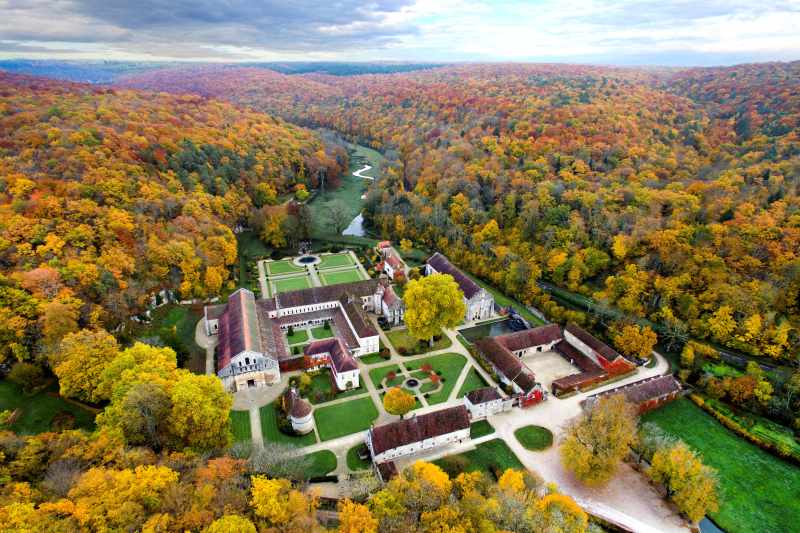
Ready to Explore the Burgundy Canal?
Guests aboard luxury hotel barges La Belle Epoque, L’Impressionniste, L’Art de Vivre, Finesse & Renaissance will have the opportunity to visit many of the sites listed above. For more information on our Burgundy itineraries and the rest of our collection of luxury hotel barge cruises, why not order a free copy of our brochure today or speak to a member of our team directly using our handy Contact Form.
 English
English
 Spanish
Spanish French
French German
German Norwegian
Norwegian Portuguese
Portuguese Swedish
Swedish Italian
Italian Russian
Russian Simplified Chinese
Simplified Chinese Japanese
Japanese